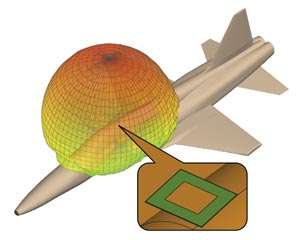Predicting the pattern

Patch antennas can now be integrated into mobile devices more efficiently using a model that predicts the signal radiation patterns of installed antennas, developed by A*STAR researchers. The model solves one of the major obstacles faced by communications engineers—predicting how the radiation pattern of a patch antenna will change when it is installed in a device.
Patch antennas, composed of metallic strips, are designed to provide efficient communication in the smallest and flattest arrangement possible. Due to their small installation footprint, patch antennas are used in many applications where saving space is paramount, such as mobile phones, wearable devices, and aircraft. The problem is, the signal pattern emitted by the patch antenna can be affected by the way it is installed and the materials around it, which adds a layer of complexity to device development.
"The radiation pattern is a key performance indicator of an antenna," explains Si-Ping Gao from the A*STAR Institute of High Performance Computing, who led the study. "The typical radiation pattern from a patch antenna looks like a mushroom pointed in the direction of maximum radiation, but when installed, the radiation pattern can be totally different. We wanted to develop a method to predict the best position to mount the patch antenna in order to get the desired radiation pattern before actually mounting it."
Although radiation pattern simulation methods exist, all require detailed geometric information about the patch antenna, which is rarely available for off-the-shelf antennas. Even with an accurate geometric representation of the patch antenna, the simulations are computationally intensive.
"Instead of using detailed geometric information, we developed an equivalent model described using a handful of design parameters based on the radiation mechanism of the patch antenna," says Gao. "We then add the platform to the model and compute the installed radiation pattern. This allows us to simulate the installed antenna radiation pattern without geometric information and avoids direct modeling of antenna structures, which greatly speeds up the simulation process."
The team demonstrated that the equivalent model simulation accurately reproduces the installed radiation pattern, making the integration of patch antennas into real devices easier and faster.
"This method can also be easily extended to other types of antennas or sensors by constructing equivalent models based on the radiation mechanism. These equivalent models could be collected in a database to facilitate efficient simulation of the installed radiation pattern of many different antennas and devices."
More information: Si-Ping Gao et al. Installed Radiation Pattern of Patch Antennas: Prediction based on a novel equivalent model., IEEE Antennas and Propagation Magazine (2015). DOI: 10.1109/MAP.2015.2437275





















